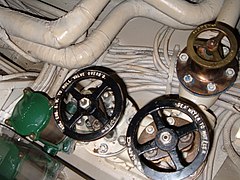Seeventil
Als Seeventil werden Absperrvorrichtungen am Rumpf eines Wasserfahrzeuges bezeichnet, die binnenbords hinter einer Borddurchführung angeordnet sind.

Funktion
Auf größeren Schiffen ist es immer als Ventil angelegt, auf kleineren Wasserfahrzeugen auch als Absperrhahn. Seeventile sind häufig auf beiden Schiffsseiten in die Bordwand eingesetzt oder an Seekästen montiert. Angeschlossen ist zumeist ein Seewasserfilter.
Das Seeventil dient zum kontrollierten Wassereinlass durch die Bordwand für die Motorkühlung, für das Feuerlöschsystem, die Deckwaschpumpen und für Brauchwasser wie die Toilettenspülung. Seeventile verhindern das Eindringen von Wasser in den Schiffsrumpf bei Defekten oder Arbeiten an den angeschlossenen Brauchwasserleitungen. Aus Sicherheitsgründen werden sie bei Nichtgebrauch geschlossen gehalten.
Insbesondere auf Kriegsschiffen gibt es auch Seeventile, die dem gewollten Fluten des Fahrzeuges oder Teilen davon dienen.
Bilder
- Figur 26 zeigt eine Anordnung mit Seeventil (Sea cock)
- Beispiel für die Anordnung eines Seeventils der USS Olympia (C-6)
- Seeventilanordnung auf USS Pampanito
- Seewasserventil (hier eigentlich -absperrhahn) einer Yacht
Literatur
- K. Schwitalla, Ulrich Scharnow: Lexikon der Seefahrt. diverse Jahrgänge, transpress VEB Verlag für Verkehrswesen Berlin, ISBN 3-344-00190-6.
Weblinks
Auf dieser Seite verwendete Medien
Autor/Urheber: BrokenSphere, Lizenz: CC BY-SA 3.0
Valves regulating the flow of sea water to certain parts of the boat located in the after engine room of the USS Pampanito (SS-383), berthed at Fisherman's Wharf in San Francisco.
A drawing of the parts inside a globe valve with numbered parts and translated labels.
Autor/Urheber: Internet Archive Book Images, Lizenz: No restrictions
Identifier: harpersboatingbo01davi (find matches)
Title: Harper's boating book for boys; a guide to motor boating, sailing, canoeing and rowing
Year: 1912 (1910s)
Authors: Davis, Charles G. (Charles Gerard), 1870-1959, ed
Subjects: Boats and boating
Publisher: New York, London, Harper & Brothers
Contributing Library: The Library of Congress
Digitizing Sponsor: The Library of Congress
View Book Page: Book Viewer
About This Book: Catalog Entry
View All Images: All Images From Book
Click here to view book online to see this illustration in context in a browseable online version of this book.
Text Appearing Before Image:
makes of centrifugalpumps (Fig. 25); but all are for the same purpose. Thosepumps get their supply of water from a pipe which goesthrough the bottom of the boat well down under water,so that when the boat rolls the pipe will not come out andsuck air instead of water (Fig. 26). This also can be eithera brass pipe or a rubber hose. Common iron pipe is aptto rust through and cause a leak which might sink theboat. In fresh water iron might last several years, but for 254 INSTALLING THE ENGINE salt water use brass by all means or else the hose. Uselock-nuts on the intake as previously described for theexhaust. If the boat is a fast one, it is a good plan tofasten some sort of a scoop (Fig. 27) to supply water tothe pipe, as without something of this sort the water isapt to shoot past the end of the pipe so fast that but littleof it will be sucked in by the pump, and without water theengine will soon run hot and give you trouble. The suction into this pipe may draw sea-weed, mud, or Fig. 25
Text Appearing After Image:
Fig. 28 Fig. 27 255 BOATING BOOK FOR BOYS any floating object, choke up the pipe, and shut off the watersupply. To prevent this a brass sieve or screen (Fig. 28)is generally fitted over the end. Sometimes when a smallboat is aground at the shore this pipe becomes clogged upwith mud; but this generally washes off after the boat hasbeen running a short time. The intake-pipe, being wellbelow water, would, if the pipe to the engine ever becamebroken, leak so as to sink the boat, and as a safeguardagainst such an accident this pipe generally has a valveor sea-cock which can be turned so as completely to shutoff all water. In leaving the boat over night this cock shouldalways be closed. While it might seem best to run all pipes as straight aspossible from the motor to the outside through the planking,yet when one considers what happens when the shaking ofthe motor begins, one can see that something is apt to giveway. Therefore, a turn in the pipe is advisable, for thisallows movement to tak
Note About Images








